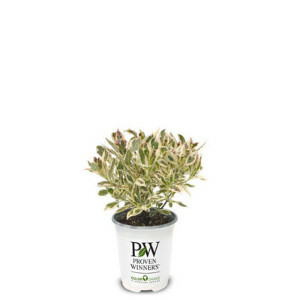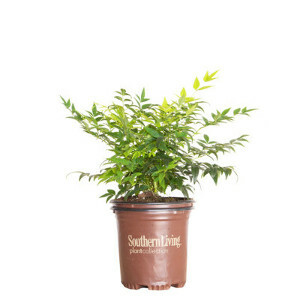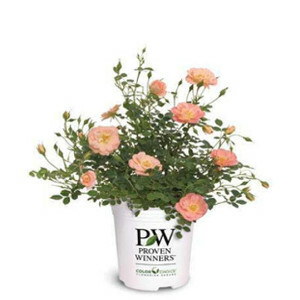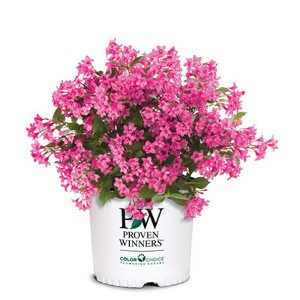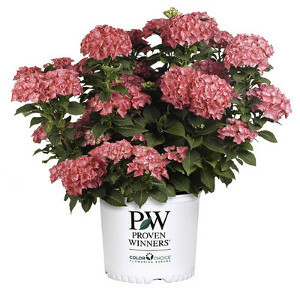- Partial Sun to Full Sun (At Least 5 Hours of Direct Sunlight)
- Mature Height 24 - 48 Inches
- Mature Spread 18 - 36 Inches
- Growing Zones 4 - 8
- Use As A Thriller In Containers
Gardeners with dedicated wildlife and pollinator areas of their garden need to include Anise Hyssop in the planting plan. This is a tough-as-nails perennial that will not only attract all the pollinators to your yard but is edible and drought tolerant. Anise Hyssop is in the mint family, although it does tend to be better behaved than most varieties of mint. Agastache foeniculum is a native of the prairies of the midwest, Great Plains and Canada. It has beautiful spikes of rose-colored flowers that last a long time on the plant as a cut flower in a vase.
Anise Hyssop can be grown in just about every state of the lower 48 and will multiply in the garden at a moderate level. This edible perennial not only looks great planted with other prairie natives like Rudbeckia and Miscanthus grasses but adds a unique vertical element when planted in the kitchen garden as a pollinator attractor. Deer do not browse this plant, and few diseases are a problem. Once Anise Hyssop has established in a garden, little maintenance is required.
Anise Hyssop Care
Plant Agastache in a sunny, well-drained spot. Shade early or late in the day is well tolerated as well as nutrient-poor soils. Prairie plants rarely need fertilizing and will always benefit from a 2-3 inch layer of organic mulch in the spring. As the mulch breaks down, it supplies nutrients to the roots. Water well the first year after planting. Deep watering once a week will encourage the roots to grow deeper in the soil and become more drought tolerant as the plant matures.
The only maintenance required for Anise Hyssop is to remove any remaining spent growth in the late winter or early spring. The top growth is enjoyed over the winter by various non-migrating birds and other wildlife visitors to the garden. Stop deadheading Agastache in late July so any remaining flowers can form seedheads.
Anise Hyssop Spacing
The tall height of Anise Hyssop looks excellent at the back of the border with other natives like Switch Grass or Coneflowers. The mature height is 4 feet (in bloom) with a spread of 3 feet. Space each plant 24 inches apart on center when planting a large group of Agastache.
Anise Hyssop Information
| USDA Hardiness Zones: 4 - 8 |
| Plant Type: Perennials |
| Light Exposure: Partial Sun to Full Sun (At Least 5 Hours of Direct Sunlight) |
| Mature Height: 24 - 48 Inches |
| Mature Spread: 18 - 36 Inches |
| Spacing: 18 - 36 Inches |
| Habit: Upright |
| Flower Color(s): Purple |
| Flower Description: Lavender |
| Bloom Period: |
| Foliage Type: Deciduous |
| Foliage Color(s): Green |
| Foliage Description: |
| Seasonal Interest: Summer Flowering, Fall Flowering |
| Watering: Low |
| Resists: Deer |
| Tolerates: Drought |
| Attracts: Butterflies, Hummingbirds |
| Container Role: Thriller |
| Uses: Borders, Containers, Mass Planting, Specimen or Focal Point |
| Features: Attracts Pollinators, Cut Flowers, Fragrant, Low Maintenance |
| Brand: American Beauties Native Plants |
| Common Name: Anise Hyssop |
| Other Name(s): |
| Scientific Name: Agastache foeniculum |
- SKU:
- 1231012828-pc
Container Sizes
Please Note: The pictures below are to give a general representation of the different container sizes. The actual size/ages of plants are estimates and will vary based on; type of plant, time of year, last pruning & many other factors.
For more detailed information, please click here.
Plant Addicts Guarantee (Included On All Plant Orders)
Plant Addicts always guarantees your plant(s) will arrive happy & healthy. However, plant(s) are being shipped through the mail & sometimes accidents happen. If the plant is dead, has dried out roots or the incorrect item was shipped, just notify Plant Addicts within 3 days upon delivery. We may ask for pictures but will try to make it as easy as possible for you. Please note, plant(s) with damaged branches or wilted leaves will not qualify for this guarantee. Plants are very resilient and will rebound quickly when cared for correctly.
For more information on how to care for your new plants, please click on our guide below.
Guide: How to Care for Your New Plant(s)
Plant Addicts Warranty - 1 Year (Extra Purchase Required)
We encourage all plant lovers to purchase the Plant Addicts Warranty, whether you're a new gardener or an expert. There are many variables outside of anyone's control that can cause a plant to die. Hungry animals, drought, poor soil conditions, over watering, diseases & pests are all good examples of what can cause plants to die. The Plant Addicts Warranty is a 1 year warranty protecting you from all of the unknowns and will replace your plant if something were to happen to it.
The warranty is purchased on a per plant basis and must be purchased at the same time as the plant(s). We will cover 100% of the price of the plant, but the warranty does not cover shipping costs. SImply let us know if your plant has died within 1 year of receiving it and we will get you a new one shipped out as soon as possible (depending on the time of the year and availability). We may ask for photos for documentation purposes, but we try to make the process as easy as possible.
For more information, please click on our page below.
Plant Shipping
Below are some factors we consider when determining when to ship the plants depending on the timing of the order.
Winter to Early Spring
We ship only when it's warm enough to plant in your growing zone.
Sometimes plants aren't completely ready to sell and ship in early spring. We will wait until the plants are ready before shipping so you don't get a subpar product.
For Southern plants we will be able to ship much earlier than plants coming from our northern nursery.
Summer
If there is extreme heat we may delay shipping for a week or several weeks.
We review what areas the plants are traveling through as well as your location.
Fall into Winter
We’ll ship plants out all the way up to the end of the fall planting season!
Winter
Get your order in early to reserve your plants for Spring planting!
Once your plant is shipped you’ll receive an automated email with tracking information.
Click here for more detailed shipping information.
Planter Shipping
Standard Colors: 2-3 business days
Special Order Colors: 8 weeks - this is due to the planter being custom made with the color(s) of your choice
Please Note: On special orders there can not be any cancellations



